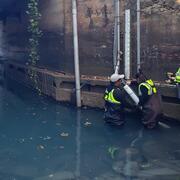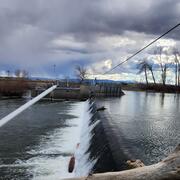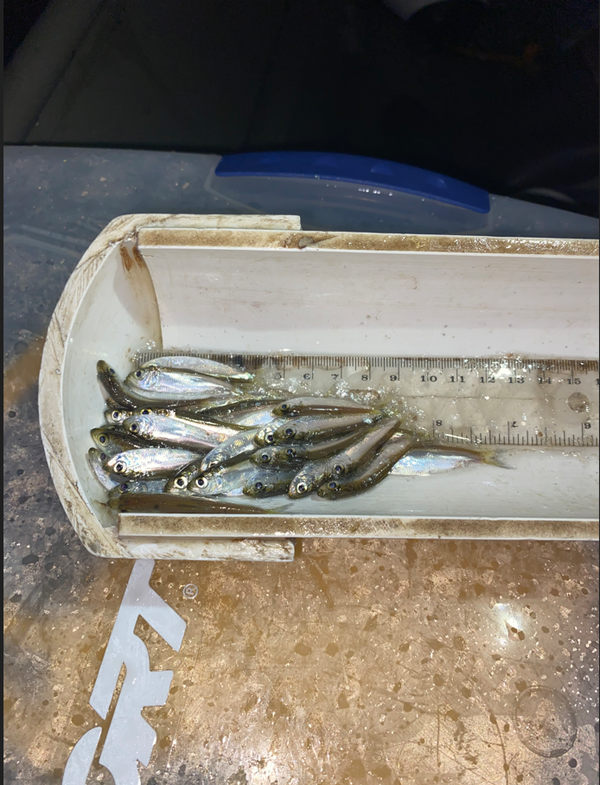Blueback herring and alewife (river herring) are two species of anadromous fish that are important in Northeast coastal rivers.
Allison Roy, PhD
Unit Leader - Massachusetts Cooperative Fish and Wildlife Research Unit
Research Interests
Allison's research broadly revolves around characterizing anthropogenic impacts on aquatic ecosystems and identifying conservation strategies for effectively protecting and restoring watersheds. The growing human population continues to constrain biotic assemblages in a variety of ways, and understanding the mechanisms by which urbanization and its associated stressors result in degraded fish assemblages is an overarching challenge of her research program. She is interested in examining effects of altered hydrology, temperature, habitat, water quality, and food resources on stream fishes; quantifying sublethal (e.g., behavior, physiology) responses of fishes to urbanization; and assessing potential for management (e.g., forested riparian buffers, green infrastructure, dam removal) to restore fish assemblages.
Teaching Interests
At the University of Massachusetts Amherst, Allison teaches Research Concepts for first-year graduate students and Aquatic Ecology for advanced undergraduate and graduate students. In the past, she has taught graduate classes in Stream Ecology and Watershed Theory & Management, and undergraduate classes in the areas of Ecology, Conservation Biology, and Environmental Science.
Professional Experience
Unit Leader, Massachusetts Cooperative Fish and Wildlife Research Unit, 2020-
Assistant Unit Leader, Massachusetts Cooperative Fish and Wildlife Research Unit, 2012-2019
Assistant Professor, Kutztown University, Department of Biology, 2009-2011
Postdoctoral Scientist, U.S. Environmental Protection Agency, Office of Research and Development, 2004-2009
Education and Certifications
Ph D The University of Georgia 2004
MS The University of Georgia 2000
BS Allegheny College 1998
Science and Products
Carbon in Urban River Biogeochemistry Project
Quality Assessment of Past Spawning Mark Estimations from a Long-Term Survey in the Connecticut River Watershed
Watershed selection to support freshwater mussel restoration: an open-loop decision guide
Restoring aquatic habitats through dam removal
Framework for Protecting Aquatic Biodiversity in the Northeast Under Changing Climates
Increasing Tribal Climate Adaptive Capacity for Coastal Resources in the Northeast
Rethinking Lake Management for Invasive Plants Under Future Climate: Sensitivity of Lake Ecosystems to Winter Water Level Drawdowns
Projecting the Future of Headwater Streams to Inform Management Decisions
Freshwater fish and mussel projections in the Northeastern United States at the HUC12 scale under different climate and land use scenarios Freshwater fish and mussel projections in the Northeastern United States at the HUC12 scale under different climate and land use scenarios
Fish species occurrence data (HUC12) in Maine, New Hampshire, Vermont, Massachusetts, Connecticut, and Rhode Island Fish species occurrence data (HUC12) in Maine, New Hampshire, Vermont, Massachusetts, Connecticut, and Rhode Island
Daily ice cover fractions for 107,257 lakes in the Northern Hemisphere Daily ice cover fractions for 107,257 lakes in the Northern Hemisphere
Watershed Level Occurrences of Yellow Lampmussel from Museum and Survey Data Watershed Level Occurrences of Yellow Lampmussel from Museum and Survey Data
A Remote Sensing Approach to Characterize Winter Water Level Drawdown Patterns in Lakes A Remote Sensing Approach to Characterize Winter Water Level Drawdown Patterns in Lakes
Data used to test a video monitoring and computational system for estimating juvenile fish abundance Data used to test a video monitoring and computational system for estimating juvenile fish abundance
A hydrological modeling framework for lake water level drawdown management A hydrological modeling framework for lake water level drawdown management
Developing a Stochastic Hydrological Model for Informing Lake Water Level Drawdown Management Developing a Stochastic Hydrological Model for Informing Lake Water Level Drawdown Management
Stream Temperature and Dissolved Oxygen Responses to Small Dams and Dam Removal in Massachusetts Stream Temperature and Dissolved Oxygen Responses to Small Dams and Dam Removal in Massachusetts
In-vitro Propagation and Fish Assessments to Inform Restoration of Dwarf Wedgemussel (Alasmidonta Heterodon) In-vitro Propagation and Fish Assessments to Inform Restoration of Dwarf Wedgemussel (Alasmidonta Heterodon)
Blueback herring and alewife (river herring) are two species of anadromous fish that are important in Northeast coastal rivers.
Urban heterogeneity drives dissolved organic matter sources, transport, and transformation from local to macro scales Urban heterogeneity drives dissolved organic matter sources, transport, and transformation from local to macro scales
Salting behaviors influence urban stream conductivity in Boston, Massachusetts (USA) Salting behaviors influence urban stream conductivity in Boston, Massachusetts (USA)
Overcoming challenges in mapping hydrography and heterogeneity in urban landscapes Overcoming challenges in mapping hydrography and heterogeneity in urban landscapes
Climate and land use drivers of freshwater fish biodiversity in the northeastern United States Climate and land use drivers of freshwater fish biodiversity in the northeastern United States
Modeling daily ice cover in northern hemisphere lakes with a long short‐term memory neural network Modeling daily ice cover in northern hemisphere lakes with a long short‐term memory neural network
Spatial and temporal variation in dissolved organic matter in urban streams in metropolitan Boston, Massachusetts (USA) Spatial and temporal variation in dissolved organic matter in urban streams in metropolitan Boston, Massachusetts (USA)
Quality assessment of past spawning mark estimations from a long-term survey in the Connecticut River watershed Quality assessment of past spawning mark estimations from a long-term survey in the Connecticut River watershed
Range-wide ecology, conservation, and research needs for yellow lampmussel (Lampsilis cariosa) Range-wide ecology, conservation, and research needs for yellow lampmussel (Lampsilis cariosa)
Restoring aquatic habitats through dam removal Restoring aquatic habitats through dam removal
Assessing methods for mitigating fungal contamination in freshwater mussel in vitro propagation Assessing methods for mitigating fungal contamination in freshwater mussel in vitro propagation
High variability of migration strategies in a re-established Cygnus buccinator (Trumpeter Swan) population High variability of migration strategies in a re-established Cygnus buccinator (Trumpeter Swan) population
River herring influence perch morphology, physiology, and life history River herring influence perch morphology, physiology, and life history
Code for freshwater fish and mussel biodiversity and distribution in the Northeastern United States under climate change and management scenarios Code for freshwater fish and mussel biodiversity and distribution in the Northeastern United States under climate change and management scenarios
Freshwater fish biodiversity and distribution in the Northeastern United States Freshwater fish biodiversity and distribution in the Northeastern United States
Prioritizing catchments for native freshwater mussel conservation in the Northeastern United States Prioritizing catchments for native freshwater mussel conservation in the Northeastern United States
A Long Short Term Memory model for predicting daily lake ice cover changes in the Northern Hemisphere A Long Short Term Memory model for predicting daily lake ice cover changes in the Northern Hemisphere
Winter Drawdown Winter Drawdown
A hydrological modeling framework for lake water level drawdown management A hydrological modeling framework for lake water level drawdown management
Science and Products
Carbon in Urban River Biogeochemistry Project
Quality Assessment of Past Spawning Mark Estimations from a Long-Term Survey in the Connecticut River Watershed
Watershed selection to support freshwater mussel restoration: an open-loop decision guide
Restoring aquatic habitats through dam removal
Framework for Protecting Aquatic Biodiversity in the Northeast Under Changing Climates
Increasing Tribal Climate Adaptive Capacity for Coastal Resources in the Northeast
Rethinking Lake Management for Invasive Plants Under Future Climate: Sensitivity of Lake Ecosystems to Winter Water Level Drawdowns
Projecting the Future of Headwater Streams to Inform Management Decisions
Freshwater fish and mussel projections in the Northeastern United States at the HUC12 scale under different climate and land use scenarios Freshwater fish and mussel projections in the Northeastern United States at the HUC12 scale under different climate and land use scenarios
Fish species occurrence data (HUC12) in Maine, New Hampshire, Vermont, Massachusetts, Connecticut, and Rhode Island Fish species occurrence data (HUC12) in Maine, New Hampshire, Vermont, Massachusetts, Connecticut, and Rhode Island
Daily ice cover fractions for 107,257 lakes in the Northern Hemisphere Daily ice cover fractions for 107,257 lakes in the Northern Hemisphere
Watershed Level Occurrences of Yellow Lampmussel from Museum and Survey Data Watershed Level Occurrences of Yellow Lampmussel from Museum and Survey Data
A Remote Sensing Approach to Characterize Winter Water Level Drawdown Patterns in Lakes A Remote Sensing Approach to Characterize Winter Water Level Drawdown Patterns in Lakes
Data used to test a video monitoring and computational system for estimating juvenile fish abundance Data used to test a video monitoring and computational system for estimating juvenile fish abundance
A hydrological modeling framework for lake water level drawdown management A hydrological modeling framework for lake water level drawdown management
Developing a Stochastic Hydrological Model for Informing Lake Water Level Drawdown Management Developing a Stochastic Hydrological Model for Informing Lake Water Level Drawdown Management
Stream Temperature and Dissolved Oxygen Responses to Small Dams and Dam Removal in Massachusetts Stream Temperature and Dissolved Oxygen Responses to Small Dams and Dam Removal in Massachusetts
In-vitro Propagation and Fish Assessments to Inform Restoration of Dwarf Wedgemussel (Alasmidonta Heterodon) In-vitro Propagation and Fish Assessments to Inform Restoration of Dwarf Wedgemussel (Alasmidonta Heterodon)
Blueback herring and alewife (river herring) are two species of anadromous fish that are important in Northeast coastal rivers.
Blueback herring and alewife (river herring) are two species of anadromous fish that are important in Northeast coastal rivers.









